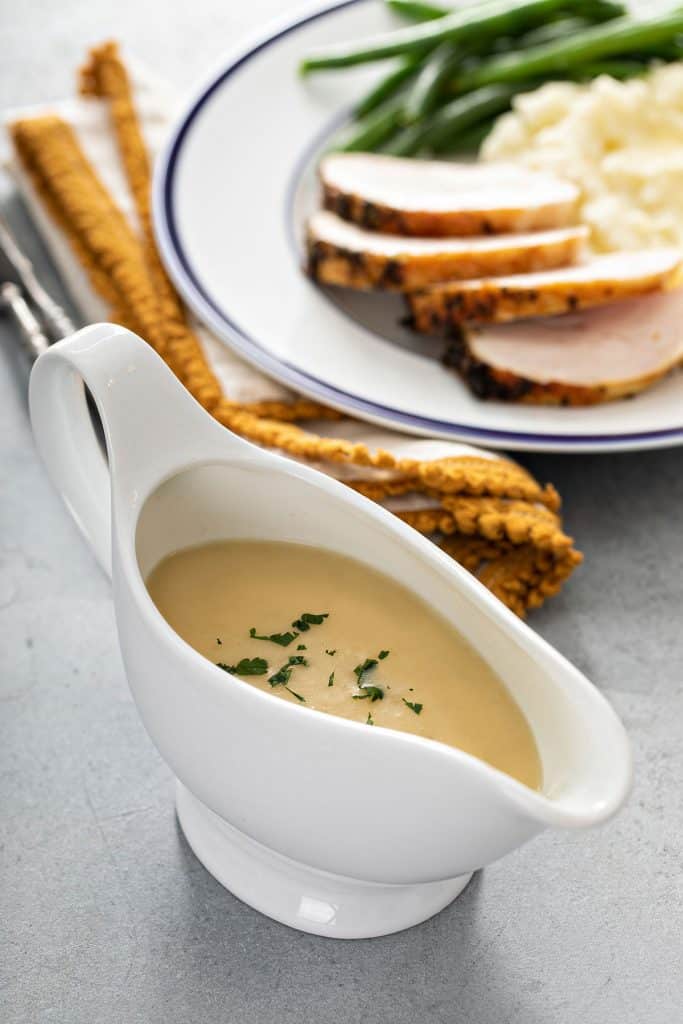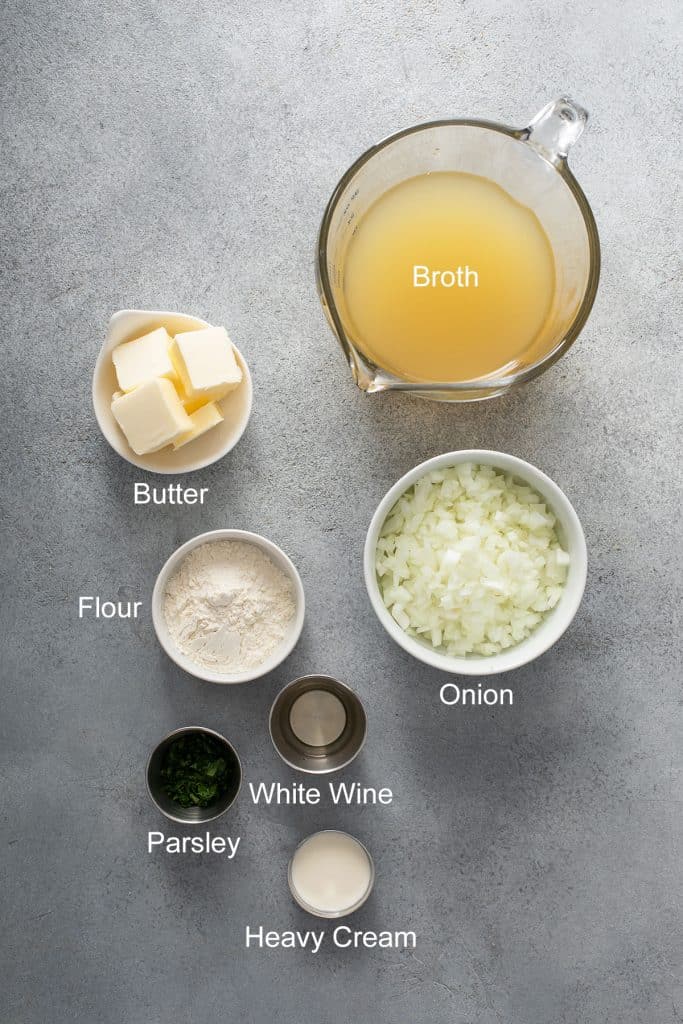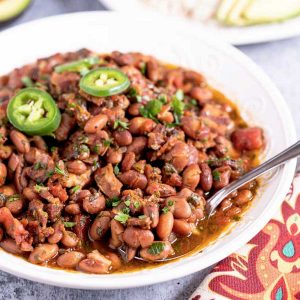Rich, smooth and luscious Homemade Turkey Gravy made with pan drippings is easy to make and absolutely delicious. Learn how to make the best gravy to pour over your Thanksgiving turkey, mashed potatoes and other side dishes.

The Best Turkey Gravy Recipe
Get your gravy boat ready! This homemade turkey gravy recipe is the real deal. No powdered instant gravy mixes or canned gravy are needed to make the best and most delicious turkey gravy for your Thanksgiving dinner.
Why You’ll Love This Recipe
- Flavor: Turkey drippings are an essential ingredient if you want to make a rich gravy with lots of deep flavor. The browned bits from the bottom of your roasting pan add extra flavor to homemade gravy however, we will show you the best option for making flavorful gravy without drippings.
- Easy: Cooking for the holidays can be stressful, especially if you are in charge of the turkey. This easy gravy recipe doesn’t require any cooking skills and comes together quickly.
- Gravy Two Ways: Whether you are a – turkey giblets in your gravy – kind of person or not, we got you covered!
Turkey drippings are the brown bits and juices collected at the bottom of the roasting pan. They are liquid gold! Don’t waste them, make gravy instead!

What You’ll Need To Make This Recipe
Check the printable recipe card below for a full list of ingredients and exact amounts.
- Turkey Drippings: The collected juices from the fat melting and the brown bits, including any tiny piece of meat that has fallen off to the bottom of the roasting pan, should be used. However if you want a completely smooth gravy (like the ones made with instant gravy powder), you will need to pass the drippings through a fine-mesh strainer. I never strain the solids because
life is too shortwhen the gravy is completely smooth it reminds me of gravy used for catering big banquets.The consistency is good but the flavor is never great. If you don’t have the amount of drippings needed, (most likely you won’t), supplement with turkey or chicken broth. - Butter: I use unsalted butter but salted butter can be used. Butter is combined with flour to make a roux.
- Broth: Turkey stock or chicken stock can be used to complete the 2 1/2 cups of liquid needed in this recipe. Making your own stock definitely results in rich turkey gravy. Making homemade turkey broth is easy and uses the turkey parts that come stored in the bird’s cavity (turkey neck, heart, liver, and gizzards). After the broth is made, the giblets get chopped up into tiny pieces and added to the gravy to make turkey gravy with giblets. A recipe for turkey stock is provided in the recipe card below.
- Flour: I use all-purpose flour as a thickening agent. When flour is mixed with fat, from the butter and drippings, it turns into a roux.
- White wine or Cognac: Both of these ingredients fortify the flavor of sauces and gravies. You only need one tablespoon of wine or cognac so if you don’t have a bottle of one of these already opened, skip it! Your gravy will still be amazingly delicious.
- Salt and Black Pepper: My mother-in-law used to say that black pepper turns a good gravy into the best gravy! The amount of black pepper you add is up to you. As for salt, always taste your gravy before adding any salt.
- Optional Ingredients:
Onion: Aromatics add flavor. Skip this ingredient if preferred.
Heavy cream: This ingredient is key if you prefer a rich and creamy gravy. A little bit (a tablespoon) goes a long way!
Fresh herbs: You can garnish the gravy with finely chopped fresh herbs. Fresh thyme is my absolute favorite followed by parsley and sage.

How To Make Homemade Turkey Gravy (from scratch)?
This is just a quick overview on how to make homemade turkey gravy. For specific instructions and times, please check the printable recipe card below.
- Get Drippings and Skim Off Fat: If using turkey drippings, remove the turkey from the roasting pan and discard any vegetables or herbs from the bottom of the pan. Pour the turkey pan juices into a fat separator or glass measuring cup. Allow some time so the fat rises to the top. Skim off the fat. Add enough broth to have 2 1/2 cups of liquid total.
- Melt Butter: In a medium saucepan, melt the butter over medium heat. If using, cook the onions until they become soft and translucent.
- Make Roux: Add the flour whisking constantly. Cook this mixture for 2-3 minutes stirring frequently.
- Whisk Away: Slowly, pour the broth, whisking constantly and vigorously to prevent any lumps. Add the cognac and mix to combine.
- Simmer and Serve: Lower the heat and simmer, stirring as needed until the gravy thickens. Stir in the heavy cream for a creamier gravy. Season to taste and garnish with fresh herbs. Pour gravy into a gravy boat and serve warm.



Homemade Turkey Gravy Tips for Success
- Cook the roux (butter + flour mixture) for a couple of minutes before adding the liquid (drippings + broth). This will take the raw flour taste from the final product.
- For a smooth gravy, adding the liquid (drippings + broth) into the roux (butter + flour mixture) is very important. If you add the broth all at once or too quickly, you’ll end up with a lumpy and clumpy broth, guaranteed.
- When adding the liquid (drippings + broth) into the roux (butter + flour mixture) whisk vigorously and constantly. This is key for a velvety smooth homemade turkey gravy.
- If your gravy is too thick, add additional broth 1 to 2 tablespoons at a time.
- If your gravy has lumps, pass it through a fine-mesh sieve to get rid of the lumps.
What to Add to Turkey Gravy to Make It Taste Better?
Here are a few tips to add extra flavor to homemade turkey gravy:
- The best way to make the tastiest turkey gravy is to use turkey drippings (the brown bits and juices collected at the bottom of the roasting pan you used to roast the turkey).
- Another way to boost the flavor of classic turkey gravy is by deglazing the roasting pan with white wine before collecting the drippings.
- Sautéing onions or shallots in butter before adding the flour to make the roux, also enhances the gravy’s flavor.
- Chopped fresh herbs such as fresh thyme and sage are also flavor enhancers. Fresh rosemary can be used in small quantities not to overpower the delicate flavor of turkey.
- When everything else fails and you need some heavy duty help to add extra flavor to turkey gravy, ingredients like soy sauce, fish sauce, Worcestershire sauce, dried mushrooms, mushroom powder and white miso can be used. Start with just a little bit as some of these ingredients can overtake and completely change the flavor of a good old-fashioned classic gravy.
Is Turkey Gravy better with Flour or Cornstarch?
I prefer making a roux with butter and flour to make homemade gravy. Cooking the flour for a couple of minutes also gives the mixture a nutty taste. In addition, flour holds better than cornstarch so if reheating is needed, a gravy made with flour is less likely to separate (or break).
What’s the Best Thickener For Gravy?
Making a roux with butter and flour, is in my opinion the best way to thicken gravy. Another option, is to add a slurry made with cornstarch and cold broth or water. From these two alternatives, flour holds the gravy together best if reheating is needed.
Making Ahead, Storing and Reheating:
Can Turkey Gravy Be Made Ahead?
Yes, gravy will keep in the refrigerator for 2- 3 days. make sure you cool the gravy completely before refrigerating.
How to Store Gravy?
Gravy can be stored in an airtight container, in the refrigerator for 2- 3 days.
How to Reheat Gravy?
Gravy can be reheated in a small saucepan over low heat stirring frequently until warm through. If your gravy is too thick, add a couple of tablespoons of broth as needed to thin it out.


The Best Homemade Turkey Gravy
Ingredients
- 6 tablespoons butter
- 1 small onion, diced (about 1 cup) (optional)
- 4 tablespoons all-purpose flour
- 2 1/2 cups of turkey drippings from a roasted turkey and/or turkey broth
- 1 tablespoon cognac brandy or white wine
- 1 tablespoon heavy cream optional
- Chopped fresh parsley thyme or sage, to garnish
- Salt and ground black pepper to taste optional
Turkey Broth (optional)
- Turkey neck and giblets from 1 turkey
- 1 small onion chopped
- 1 large carrot chopped
- 1 celery stalk chopped
- 1 small bay leaf
- 3 cups water
- 3 cups low sodium chicken stock or broth
Instructions
- If using turkey drippings, discard any vegetables or herbs from the roasting pan and pour the turkey pan juices into a glass measuring cup. Allow it to rest until the fat rises to the top. Skim off the fat. Add enough broth to have 2 1/2 cups of liquid total.
- Sauté Onions: In a medium saucepan melt the butter over medium heat. If using, cook the onions until they become soft and translucent, about 8-10 minutes.
- Make a roux: Add the flour whisking constantly. Cook this mixture for 2-3 minutes stirring frequently.
- Add drippings/broth: Slowly, pour the broth, whisking constantly and vigorously to prevent any lumps. Add the cognac and mix to combine.
- Simmer: Lower the heat and simmer, stirring as needed for about 4-5 minutes or until the gravy thickens. Stir in the heavy cream (if using). Season to taste with ground black pepper if desired and garnish with fresh herbs. Transfer to a gravy boat and serve.
To Make Turkey Broth (optional)
- In a heavy saucepan place the turkey neck and giblets (the liver should only be added during the last 15 minutes of cooking). Add the chopped onion, carrots, celery and bay leaf. Pour water and broth over and bring to a boil over medium-high heat. Lower the heat to medium low and simmer for about 45 minutes to 1 hour or until reduced to about 4 cups. If using, add the turkey liver during the last 15 minutes of cooking. Strain the stock and reserve.
- If you like to add bits of turkey neck meat and/or giblets into your gravy, pull the meat from the turkey neck and chop the meat and giblets finely. Reserve.
Recipe Notes
- For your convenience, we are including a homemade turkey broth recipe. This is an optional step as you can use store bought chicken or turkey broth if preferred.
- If you don’t have any turkey drippings, use 2 1/2 cups of turkey broth.
- The gravy will continue to get thick as it sits. Add additional broth to thin it out if needed.
- If you like, you can add the finely chopped giblets and turkey neck meat to the gravy at the same time that you add the cognac.
- For a silky smooth gravy, strain the pan drippings before adding them to the gravy.
- This recipe yields about 3 cups of turkey gravy. each serving is approximately 1/3 cup
- If making homemade turkey broth: If using turkey liver, add it only during the last 15 minutes of cooking time.










Leave a Reply